Question Number 41561 by Tawa1 last updated on 09/Aug/18
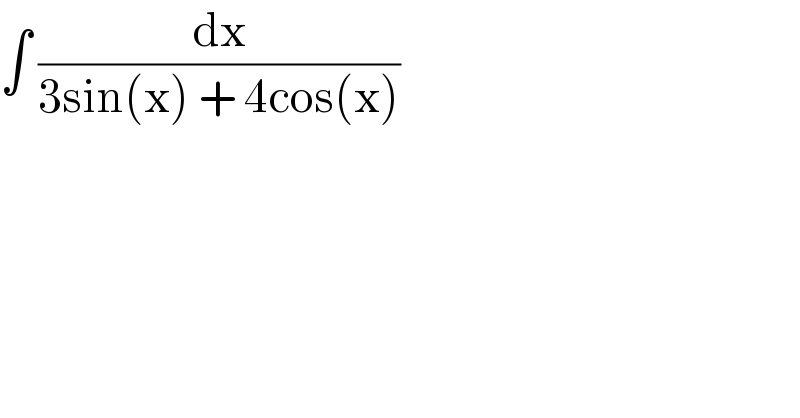
$$\int\:\frac{\mathrm{dx}}{\mathrm{3sin}\left(\mathrm{x}\right)\:+\:\mathrm{4cos}\left(\mathrm{x}\right)} \\ $$
Commented by math khazana by abdo last updated on 09/Aug/18
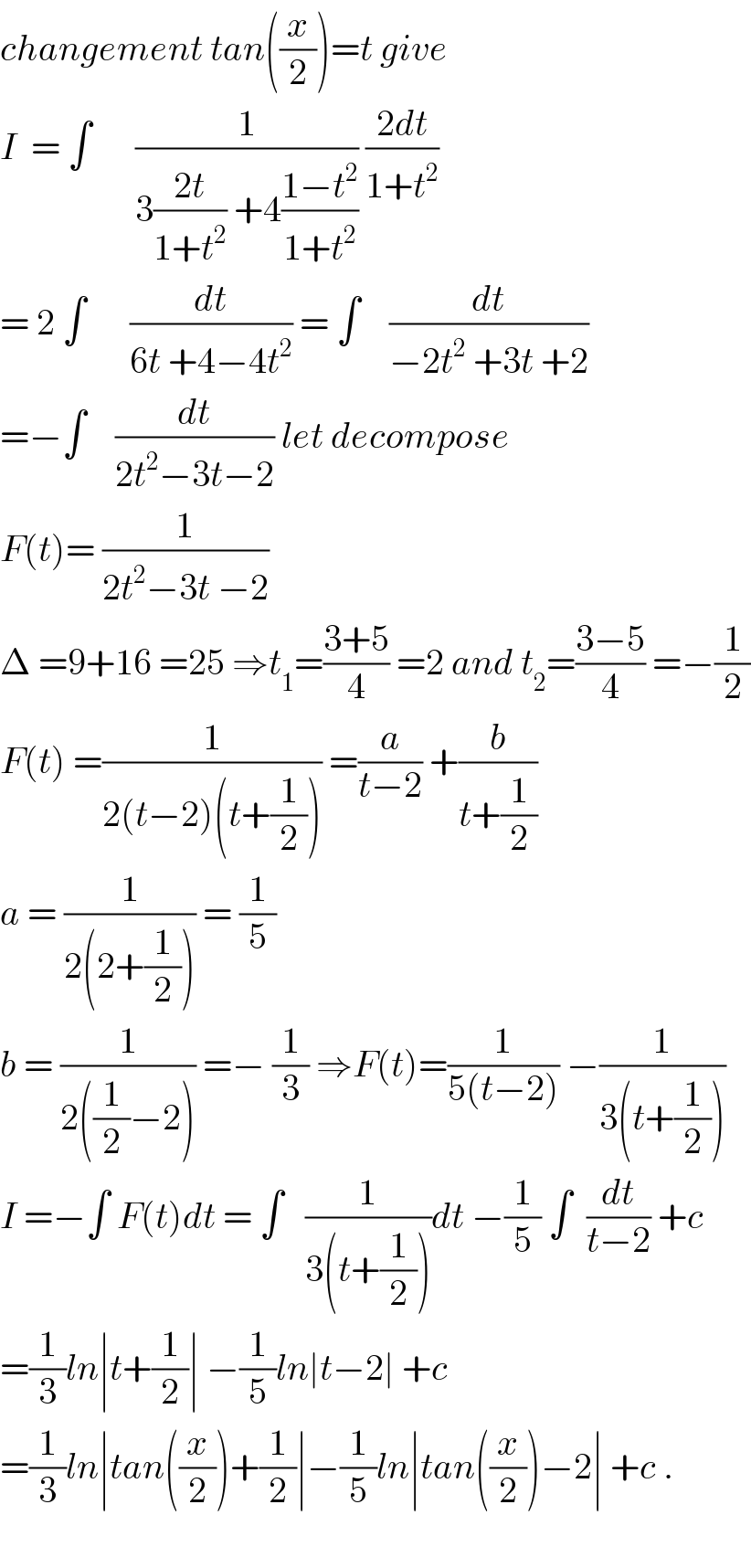
$${changement}\:{tan}\left(\frac{{x}}{\mathrm{2}}\right)={t}\:{give} \\ $$$${I}\:\:=\:\int\:\:\:\:\:\:\frac{\mathrm{1}}{\mathrm{3}\frac{\mathrm{2}{t}}{\mathrm{1}+{t}^{\mathrm{2}} }\:+\mathrm{4}\frac{\mathrm{1}−{t}^{\mathrm{2}} }{\mathrm{1}+{t}^{\mathrm{2}} }}\:\frac{\mathrm{2}{dt}}{\mathrm{1}+{t}^{\mathrm{2}} } \\ $$$$=\:\mathrm{2}\:\int\:\:\:\:\:\:\frac{{dt}}{\mathrm{6}{t}\:+\mathrm{4}−\mathrm{4}{t}^{\mathrm{2}} }\:=\:\int\:\:\:\:\frac{{dt}}{−\mathrm{2}{t}^{\mathrm{2}} \:+\mathrm{3}{t}\:+\mathrm{2}} \\ $$$$=−\int\:\:\:\:\frac{{dt}}{\mathrm{2}{t}^{\mathrm{2}} −\mathrm{3}{t}−\mathrm{2}}\:{let}\:{decompose} \\ $$$${F}\left({t}\right)=\:\frac{\mathrm{1}}{\mathrm{2}{t}^{\mathrm{2}} −\mathrm{3}{t}\:−\mathrm{2}} \\ $$$$\Delta\:=\mathrm{9}+\mathrm{16}\:=\mathrm{25}\:\Rightarrow{t}_{\mathrm{1}} =\frac{\mathrm{3}+\mathrm{5}}{\mathrm{4}}\:=\mathrm{2}\:{and}\:{t}_{\mathrm{2}} =\frac{\mathrm{3}−\mathrm{5}}{\mathrm{4}}\:=−\frac{\mathrm{1}}{\mathrm{2}} \\ $$$${F}\left({t}\right)\:=\frac{\mathrm{1}}{\mathrm{2}\left({t}−\mathrm{2}\right)\left({t}+\frac{\mathrm{1}}{\mathrm{2}}\right)}\:=\frac{{a}}{{t}−\mathrm{2}}\:+\frac{{b}}{{t}+\frac{\mathrm{1}}{\mathrm{2}}} \\ $$$${a}\:=\:\frac{\mathrm{1}}{\mathrm{2}\left(\mathrm{2}+\frac{\mathrm{1}}{\mathrm{2}}\right)}\:=\:\frac{\mathrm{1}}{\mathrm{5}} \\ $$$${b}\:=\:\frac{\mathrm{1}}{\mathrm{2}\left(\frac{\mathrm{1}}{\mathrm{2}}−\mathrm{2}\right)}\:=−\:\frac{\mathrm{1}}{\mathrm{3}}\:\Rightarrow{F}\left({t}\right)=\frac{\mathrm{1}}{\mathrm{5}\left({t}−\mathrm{2}\right)}\:−\frac{\mathrm{1}}{\mathrm{3}\left({t}+\frac{\mathrm{1}}{\mathrm{2}}\right)} \\ $$$${I}\:=−\int\:{F}\left({t}\right){dt}\:=\:\int\:\:\:\frac{\mathrm{1}}{\mathrm{3}\left({t}+\frac{\mathrm{1}}{\mathrm{2}}\right)}{dt}\:−\frac{\mathrm{1}}{\mathrm{5}}\:\int\:\:\frac{{dt}}{{t}−\mathrm{2}}\:+{c} \\ $$$$=\frac{\mathrm{1}}{\mathrm{3}}{ln}\mid{t}+\frac{\mathrm{1}}{\mathrm{2}}\mid\:−\frac{\mathrm{1}}{\mathrm{5}}{ln}\mid{t}−\mathrm{2}\mid\:+{c} \\ $$$$=\frac{\mathrm{1}}{\mathrm{3}}{ln}\mid{tan}\left(\frac{{x}}{\mathrm{2}}\right)+\frac{\mathrm{1}}{\mathrm{2}}\mid−\frac{\mathrm{1}}{\mathrm{5}}{ln}\mid{tan}\left(\frac{{x}}{\mathrm{2}}\right)−\mathrm{2}\mid\:+{c}\:. \\ $$$$ \\ $$
Commented by Tawa1 last updated on 10/Aug/18

$$\mathrm{God}\:\mathrm{bless}\:\mathrm{you}\:\mathrm{sir} \\ $$
Commented by math khazana by abdo last updated on 10/Aug/18

$${thank}\:{you}\:{sir} \\ $$
Answered by tanmay.chaudhury50@gmail.com last updated on 09/Aug/18
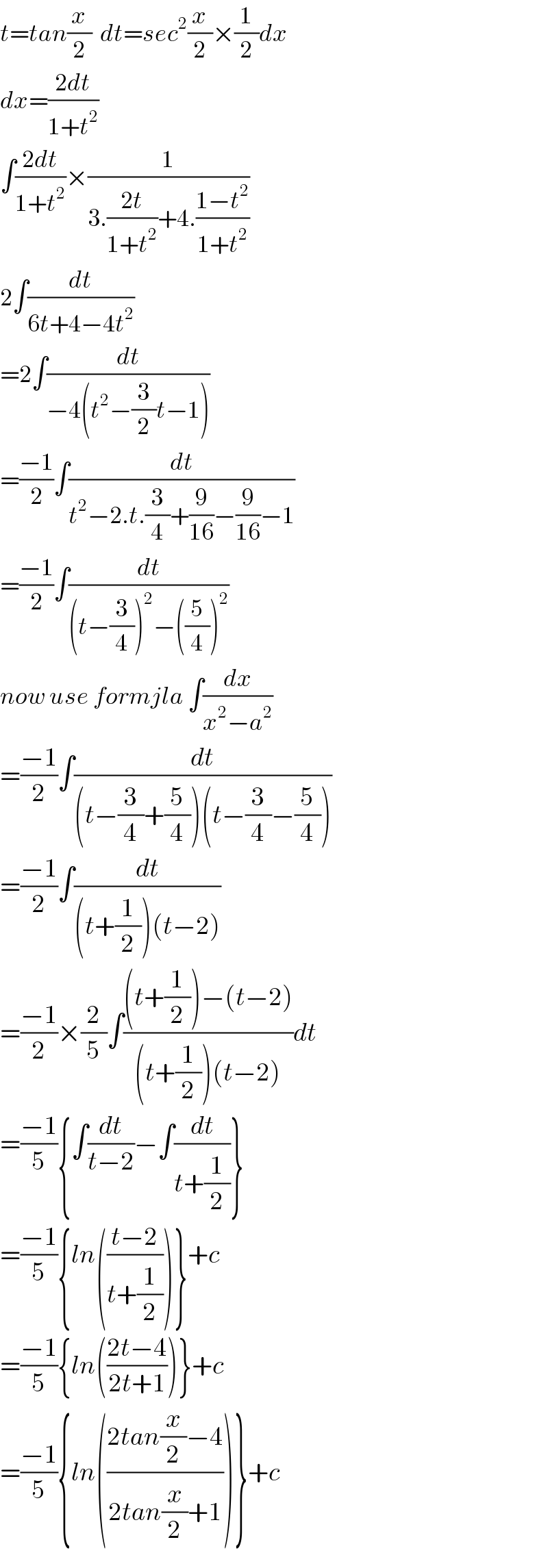
$${t}={tan}\frac{{x}}{\mathrm{2}}\:\:{dt}={sec}^{\mathrm{2}} \frac{{x}}{\mathrm{2}}×\frac{\mathrm{1}}{\mathrm{2}}{dx} \\ $$$${dx}=\frac{\mathrm{2}{dt}}{\mathrm{1}+{t}^{\mathrm{2}} } \\ $$$$\int\frac{\mathrm{2}{dt}}{\mathrm{1}+{t}^{\mathrm{2}} }×\frac{\mathrm{1}}{\mathrm{3}.\frac{\mathrm{2}{t}}{\mathrm{1}+{t}^{\mathrm{2}} }+\mathrm{4}.\frac{\mathrm{1}−{t}^{\mathrm{2}} }{\mathrm{1}+{t}^{\mathrm{2}} }} \\ $$$$\mathrm{2}\int\frac{{dt}}{\mathrm{6}{t}+\mathrm{4}−\mathrm{4}{t}^{\mathrm{2}} } \\ $$$$=\mathrm{2}\int\frac{{dt}}{−\mathrm{4}\left({t}^{\mathrm{2}} −\frac{\mathrm{3}}{\mathrm{2}}{t}−\mathrm{1}\right)} \\ $$$$=\frac{−\mathrm{1}}{\mathrm{2}}\int\frac{{dt}}{{t}^{\mathrm{2}} −\mathrm{2}.{t}.\frac{\mathrm{3}}{\mathrm{4}}+\frac{\mathrm{9}}{\mathrm{16}}−\frac{\mathrm{9}}{\mathrm{16}}−\mathrm{1}} \\ $$$$=\frac{−\mathrm{1}}{\mathrm{2}}\int\frac{{dt}}{\left({t}−\frac{\mathrm{3}}{\mathrm{4}}\right)^{\mathrm{2}} −\left(\frac{\mathrm{5}}{\mathrm{4}}\right)^{\mathrm{2}} } \\ $$$${now}\:{use}\:{formjla}\:\int\frac{{dx}}{{x}^{\mathrm{2}} −{a}^{\mathrm{2}} } \\ $$$$=\frac{−\mathrm{1}}{\mathrm{2}}\int\frac{{dt}}{\left({t}−\frac{\mathrm{3}}{\mathrm{4}}+\frac{\mathrm{5}}{\mathrm{4}}\right)\left({t}−\frac{\mathrm{3}}{\mathrm{4}}−\frac{\mathrm{5}}{\mathrm{4}}\right)} \\ $$$$=\frac{−\mathrm{1}}{\mathrm{2}}\int\frac{{dt}}{\left({t}+\frac{\mathrm{1}}{\mathrm{2}}\right)\left({t}−\mathrm{2}\right)} \\ $$$$=\frac{−\mathrm{1}}{\mathrm{2}}×\frac{\mathrm{2}}{\mathrm{5}}\int\frac{\left({t}+\frac{\mathrm{1}}{\mathrm{2}}\right)−\left({t}−\mathrm{2}\right)}{\left({t}+\frac{\mathrm{1}}{\mathrm{2}}\right)\left({t}−\mathrm{2}\right)}{dt} \\ $$$$=\frac{−\mathrm{1}}{\mathrm{5}}\left\{\int\frac{{dt}}{{t}−\mathrm{2}}−\int\frac{{dt}}{{t}+\frac{\mathrm{1}}{\mathrm{2}}}\right\} \\ $$$$=\frac{−\mathrm{1}}{\mathrm{5}}\left\{{ln}\left(\frac{{t}−\mathrm{2}}{{t}+\frac{\mathrm{1}}{\mathrm{2}}}\right)\right\}+{c} \\ $$$$=\frac{−\mathrm{1}}{\mathrm{5}}\left\{{ln}\left(\frac{\mathrm{2}{t}−\mathrm{4}}{\mathrm{2}{t}+\mathrm{1}}\right)\right\}+{c} \\ $$$$=\frac{−\mathrm{1}}{\mathrm{5}}\left\{{ln}\left(\frac{\mathrm{2}{tan}\frac{{x}}{\mathrm{2}}−\mathrm{4}}{\mathrm{2}{tan}\frac{{x}}{\mathrm{2}}+\mathrm{1}}\right)\right\}+{c} \\ $$
Commented by Tawa1 last updated on 09/Aug/18

$$\mathrm{God}\:\mathrm{bless}\:\mathrm{you}\:\mathrm{sir} \\ $$
Commented by Tawa1 last updated on 09/Aug/18

$$\mathrm{Umm}.\:\mathrm{i}\:\mathrm{would}\:\mathrm{love}\:\mathrm{it}\:\mathrm{if}\:\mathrm{you}\:\mathrm{can}\:\mathrm{finish}\:\mathrm{it}\:\mathrm{sir}.\:\mathrm{God}\:\mathrm{bless}\:\mathrm{you}\:\mathrm{sir}. \\ $$$$\mathrm{I}\:\mathrm{am}\:\mathrm{just}\:\mathrm{learning} \\ $$
Commented by Tawa1 last updated on 09/Aug/18

$$\mathrm{I}\:\mathrm{appreciate}\:\mathrm{your}\:\mathrm{effort}\:\mathrm{sir}.\:\mathrm{God}\:\mathrm{bless}\:\mathrm{you} \\ $$
Commented by tanmay.chaudhury50@gmail.com last updated on 09/Aug/18

$${actually}\:{i}\:{do}\:{not}\:{remember}\:{formula}…{but}\:{know} \\ $$$${how}\:{the}\:{formula}\:{is}\:{derived}…{now}\:{i}\:{am}\:\mathrm{48}{years} \\ $$$${but}\:{still}\:{iknow}\:{how}\:{the}\:{formula}\:{i}\:{use}\:\:{are}\:{derived} \\ $$
Commented by Tawa1 last updated on 09/Aug/18

$$\mathrm{Noted}\:\mathrm{sir} \\ $$
Commented by MJS last updated on 09/Aug/18
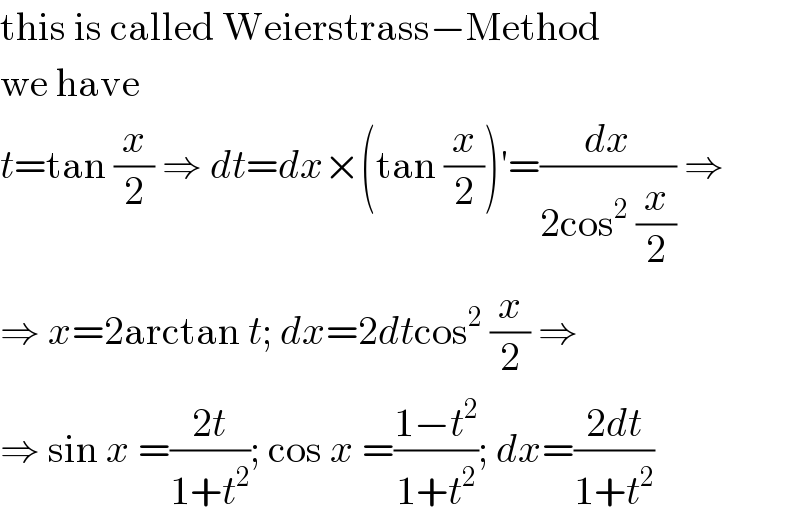
$$\mathrm{this}\:\mathrm{is}\:\mathrm{called}\:\mathrm{Weierstrass}−\mathrm{Method} \\ $$$$\mathrm{we}\:\mathrm{have} \\ $$$${t}=\mathrm{tan}\:\frac{{x}}{\mathrm{2}}\:\Rightarrow\:{dt}={dx}×\left(\mathrm{tan}\:\frac{{x}}{\mathrm{2}}\right)'=\frac{{dx}}{\mathrm{2cos}^{\mathrm{2}} \:\frac{{x}}{\mathrm{2}}}\:\Rightarrow \\ $$$$\Rightarrow\:{x}=\mathrm{2arctan}\:{t};\:{dx}=\mathrm{2}{dt}\mathrm{cos}^{\mathrm{2}} \:\frac{{x}}{\mathrm{2}}\:\Rightarrow \\ $$$$\Rightarrow\:\mathrm{sin}\:{x}\:=\frac{\mathrm{2}{t}}{\mathrm{1}+{t}^{\mathrm{2}} };\:\mathrm{cos}\:{x}\:=\frac{\mathrm{1}−{t}^{\mathrm{2}} }{\mathrm{1}+{t}^{\mathrm{2}} };\:{dx}=\frac{\mathrm{2}{dt}}{\mathrm{1}+{t}^{\mathrm{2}} } \\ $$
Answered by tanmay.chaudhury50@gmail.com last updated on 09/Aug/18
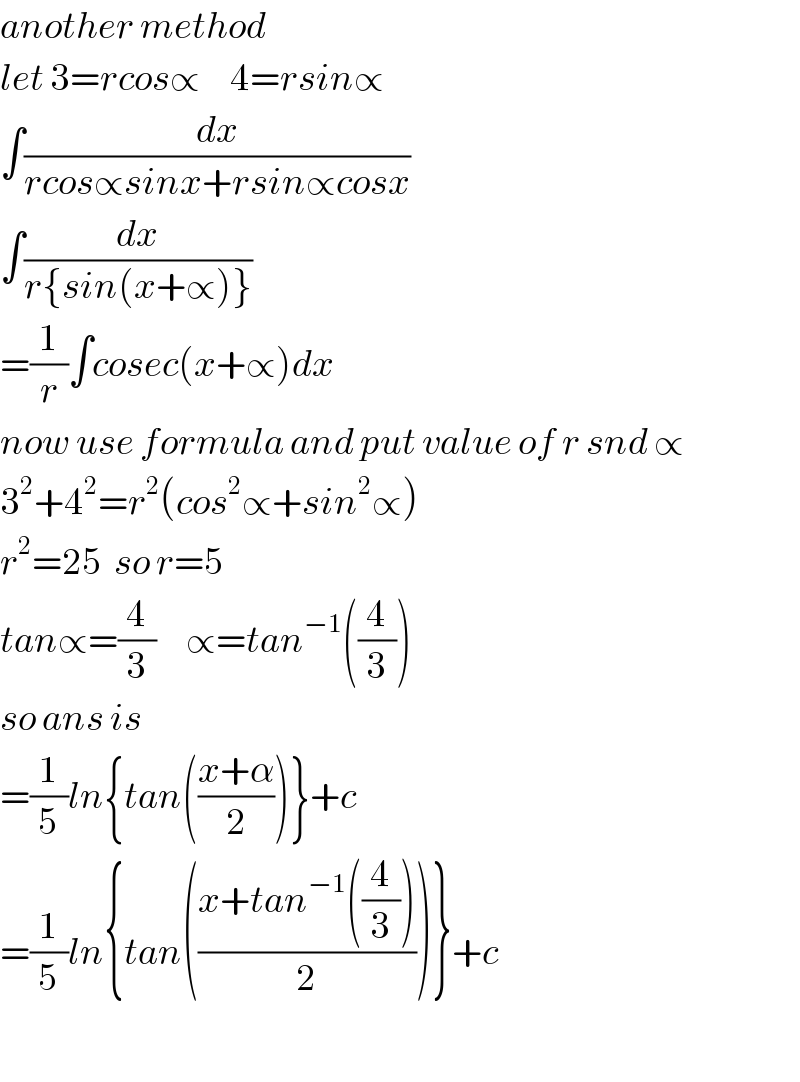
$${another}\:{method} \\ $$$${let}\:\mathrm{3}={rcos}\propto\:\:\:\:\:\mathrm{4}={rsin}\propto \\ $$$$\int\frac{{dx}}{{rcos}\propto{sinx}+{rsin}\propto{cosx}} \\ $$$$\int\frac{{dx}}{{r}\left\{{sin}\left({x}+\propto\right)\right\}} \\ $$$$=\frac{\mathrm{1}}{{r}}\int{cosec}\left({x}+\propto\right){dx} \\ $$$${now}\:{use}\:{formula}\:{and}\:{put}\:{value}\:{of}\:{r}\:{snd}\:\propto \\ $$$$\mathrm{3}^{\mathrm{2}} +\mathrm{4}^{\mathrm{2}} ={r}^{\mathrm{2}} \left({cos}^{\mathrm{2}} \propto+{sin}^{\mathrm{2}} \propto\right) \\ $$$${r}^{\mathrm{2}} =\mathrm{25}\:\:{so}\:{r}=\mathrm{5} \\ $$$${tan}\propto=\frac{\mathrm{4}}{\mathrm{3}}\:\:\:\:\:\propto={tan}^{−\mathrm{1}} \left(\frac{\mathrm{4}}{\mathrm{3}}\right) \\ $$$${so}\:{ans}\:{is}\: \\ $$$$=\frac{\mathrm{1}}{\mathrm{5}}{ln}\left\{{tan}\left(\frac{{x}+\alpha}{\mathrm{2}}\right)\right\}+{c} \\ $$$$=\frac{\mathrm{1}}{\mathrm{5}}{ln}\left\{{tan}\left(\frac{{x}+{tan}^{−\mathrm{1}} \left(\frac{\mathrm{4}}{\mathrm{3}}\right)}{\mathrm{2}}\right)\right\}+{c} \\ $$$$ \\ $$
Commented by Tawa1 last updated on 09/Aug/18

$$\mathrm{I}\:\mathrm{really}\:\mathrm{appreciate}\:\mathrm{sir}.\:\mathrm{God}\:\mathrm{bless}\:\mathrm{you}. \\ $$
